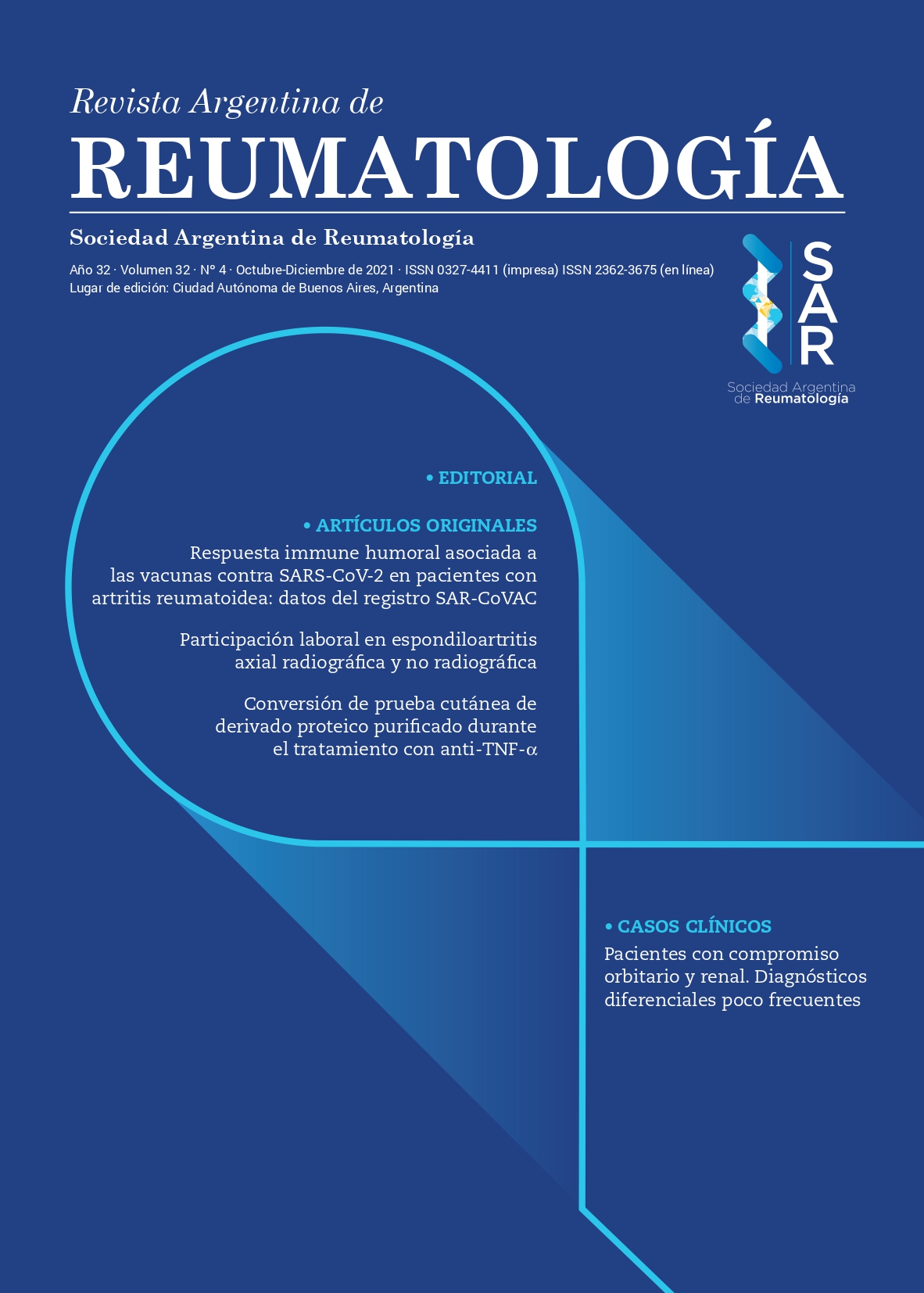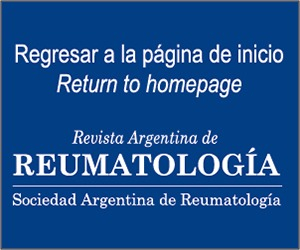Taping en rizartrosis
Resumen
Introducción: la osteoartritis (OA) de manos es una de las patologías particulares más frecuentes en la consulta diaria. Una de las localizaciones de la OA comúnmente afectada es la articulación trapecio 1° metacarpiana (TPM), denominada rizartrosis, que puede traer, además del dolor, alteraciones funcionales. Respecto al tratamiento, guías nacionales e internacionales recomiendan el uso de ortesis y ejercicios. El taping o vendaje neuromuscular actúa sobre estímulos propioceptivos generando analgesia sin limitación de la movilidad articular. Objetivo: evaluar los efectos de la aplicación de taping, comparado con el tratamiento ortésico convencional, en un programa de rehabilitación de rizartrosis. Material y métodos: fueron incluidos pacientes de ambos sexos, mayores de 45 años con OA primaria que cumplían los criterios clínicos grado II-III de Eaton, y radiológicos grado 2-3 de Kellgren y Lawrence. Fueron divididos aleatoriamente en dos grupos, el GRUPO TAPING (GT) en donde se realizó un vendaje para la TPM y el GRUPO FÉRULA (GF) a quienes se les realizó una ortesis tipo Spica corta en termomoldeable. Todos iniciaron un programa de ejercicios específicos y fueron instruidos en principios de protección articular (PPA). Fueron evaluados al inicio y al mes del tratamiento: dolor (VAS), fuerza muscular (dinamómetro Jamar), habilidad y destreza (picking up test), capacidad funcional (Australian Canadian Osteoarthritis Hand Index: AUSCAN). Para el análisis estadístico se utilizó la prueba T Student, del programa Excel versión 2010. Resultados: fueron ingresados 40 pacientes, 20 en el grupo GF y 20 en el GT. Ambos grupos mejoraron significativamente el dolor al mes de tratamiento con respecto a la evaluación basal: GF= Xi: 5,8 - Xf: 4,2 (p.0013) y GT Xi= 6,1 - Xf= 3,5 (p.0003); y el AUSCAN total GF: Xi: 40 Xf: 35 (p.0028) y GT: Xi: 39 - Xf: 29 (p.007). En cuanto a las subescalas del AUSCAN ambos grupos mejoraron significativamente el dolor y función, solo se encontró una mejoría estadísticamente significativa en la rigidez en el grupo taping GT: Xi 2,65 - Xf: 1,95 (p.004). Conclusiones: en la población estudiada encontramos que ambas modalidades terapéuticas son recomendadas en el tratamiento de rehabilitación conservador de la rizartrosis; observándose mejoría en los parámetros de dolor y función. Sin embargo, el presente estudio indica que se obtienen mejores resultados en la evaluación de la rigidez en el grupo taping comparado con el grupo férula.Citas
I. Guías Argentinas de Práctica Clínica para el diag-nóstico y tratamiento de la osteoartritis 2010.
II. Zhang W, Doherty M, Leeb BF, Alekseeva L, Arden NK, Bijlsma JW, Dinçer F, Dziedzic K, Häusel-mann HJ, Herrero-Beaumont G, Kaklamanis P, Lohmander S, Maheu E, Martín-Mola E, Pavelka K, Punzi L, Reiter S, Sautner J, Smolen J, Verbruggen G, Zimmermann-Górska I. EULAR evidence based recommendations for the management of hand os-teoarthritis: report of a Task Force of the EULAR Standing Committee for International Clinical Studies Including Therapeutics (ESCISIT). Ann Rheum Dis. 2007 Mar; 66(3):377-88.
III. Hochberg MC, Altman RD, April KT, Benkhalti M, Guyatt G, McGowan J, Towheed T, Welch V, Wells G, Tugwell P; American College of Rheumatology. American College of Rheumatology 2012 Recom-mendations for the Use of Nonpharmacologic and Pharmacologic Therapies in Osteoarthritis of the Hand, Hip, and Knee Arthritis Care & Research. Vol. 64, No. 4, April 2012, pp 465-474.
IV. Towheed TE. Systematic review of therapies for os-teoarthritis of the hand. Osteoarthritis Cartilage 2005 Jun; 13(6):455-62.
V. Hochberg MC, Altman RD, April KT, Benkhalti M, Guyatt G, McGowan J, Towheed T, Welch V, Wells G, Tugwell P. Recommendations for the use of nonpharmacologic and pharmacologic therapies in osteoarthritis of the hand, hip and knee. Arthritis Care Res (Hoboken) 2012 Apr; 64(4):465-74. Ame-rican College of Rheumatology, 2012.
VI. Kjeken I, Smedslund G, Moe RH, Slatkowsky-Christensen B, Uhlig T, Hagen KB. Systematic review of design and effects of splints and exercise programs in hand osteoarthritis. Arthritis Care & Reserarch Vo. 63 N° 6, June 2011. PP 834-848.
VII. Rogers MW, Wilder FV. Exercise and hand Os-teoarthritis Symtomatology: A controlled crossover trial. Journal Hand Therapy 2009; 22:10-18.
VIII. Kamper SJ, Henschke N. Kinesio taping for sports injuries.Br J Sports Med. 2013 Nov; 47(17):1128-9.
IX. Morris D, Jones D, Ryan H, Ryan CG. The clinical effects of Kinesio® Tex taping: A systematic review. Physiother Theory Pract. 2013 May; 29(4):259-70.
X. Taping for knee osteoarthritis. Handbook of Non Drug Intervention (HANDI). Aust Fam Physician. 2013 Oct; 42(10):725-6.
XI. Hinman RS, Bennell KL, Crossley KM, McCon-nell J. Inmediate effects of adhesive tape on pain and disability in individuals with knee osteoarthritis. Rheumatology 2003; 42:865-869.
XII. Szczegielniak J, Łuniewski J, Bogacz K, Sliwiński Z. The use of kinesiology taping method in patients with rheumatoid hand –pilot study. Ortop Trauma-tology Rehabil. 2012. Jan-Feb 14 (1); 23-30.
XIII. Eaton RG, Glickel SZ, Littler JW. Trapeziome-tacarpal osteoarthritis: Stating as a rationale for treatment. Hand Clin 1987; 3(4):455-71.
XIV. Rogers MW, Wilder FV. Exercise and hand os-teoathritis symptomatology: a controlled crossover trial. J Hand Ther 2009; 22:10-18.
XV. Cordery JC. Joint protection: a responsibility of the occupational therapist. Am J OccupTher. 1965; 19(5):285-94.
XVI. Bellamy N, Campbell J, Haraoui B, Gerecz-Simon E, Buchbinder R, Hobby K, MacDermid JC. Clini-metric properties of the, AUSCAN, Osteoarthritis HandIndex: an evaluation of reliability, validity and responsiveness. Osteoarthritis Cartilage. 2002 Nov; 10(11):863-9.
XVII. Stamm T, Mathis M, Aletaha D, Kloppenburg M, MacholdK, Smolen J. Mapping hand functioning in hand osteoarthritis: comparing self-report ins-truments with a comprehensive hand function test. Arthritis Rheum. 2007; 57:1230-7.
XVIII. Cusa MA, Alsina G, Papasidero S B, Rillo Oscar. Correlation Between the Auscan Index and Stren-gth, Dexterity and Function Tests in Patients With Primary Osteoarthritis of the Hand .J Clin Rheu-matol. 2006; 12 (4):p25.
XIX. Dias R, Chandrasenan J, Rajaratnam V, Burke FD. Basal thumb arthritis. Postgrad Med J 2007; 83:40-3.
XX. Kjeken I, Smedslund G, Moe RH, Slatkowsky-Christensen B, Uhlig T, Hagen KB. Systematic review of design and effects of splints and exercise programs in hand osteoarthritis. Arthritis Care Res (Hoboken). 2011 Jun;63(6):834-48.
XXI. Rannou F, Poiraudeau S. Non-pharmacological ap-proaches for the treatment of osteoarthritis. Best Pract Res Clin Rheumatol. 2010 Feb; 24(1):93-106.
XXII. Kloppenburg M. Hand osteoarthritis-nonpharma-cological and pharmacological treatments. Nat Rev Rheumatol. 2014 Apr; 10(4):242-51.
XXIII. Wajon A, Ada L. No difference between two splint and exercise regimens for people with osteoarthritis of the thumb: a randomised controlled trial. Aust J Physiother 2005; 51(4):245-9
XXIV. Egan MY, Brousseau L. Splinting for osteoarthritis of the carpometacarpal joint: a review of the eviden-ce. Am J Occup Ther. 2007; 61:70-78.
XXV. Rannou F, Dimet J, Boutron I, Baron G, Fayd F, Macé Y, et al. Splint for base of thumb osteoarthritis: a radomized trial. Ann Intern Med 2009; 150:661-9.
Derechos de autor 2014 Revista Argentina de Reumatología

Esta obra está bajo licencia internacional Creative Commons Reconocimiento-NoComercial-SinObrasDerivadas 4.0.






